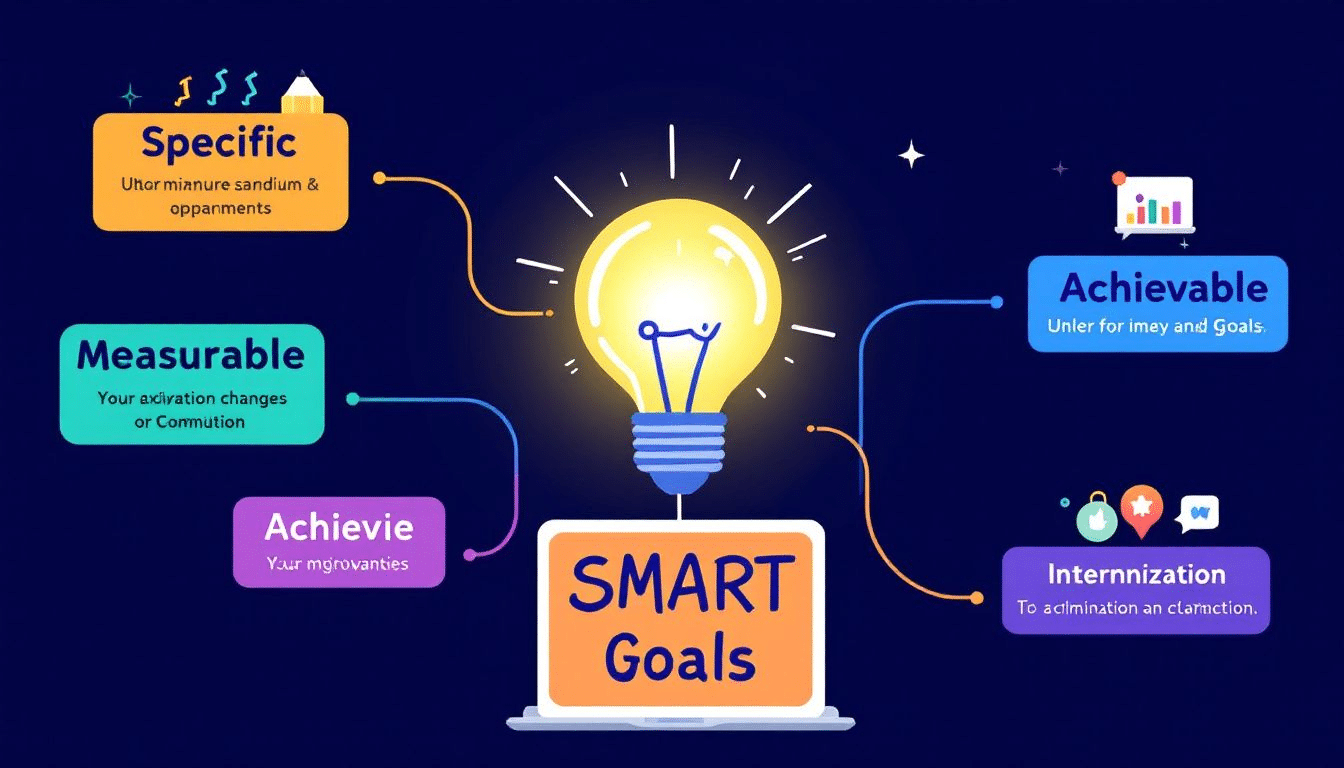If you’re looking to achieve your dreams, setting goals is key. This article will show you an example of how you set goals—give me an example of how you set goals effectively—giving you actionable steps to make your aspirations a reality.
Key Takeaways
Goal setting gives direction and purpose, transforming aspirations into actionable plans for personal and professional growth.
Utilize the SMART criteria (Specific, Measurable, Achievable, Relevant, Time-bound) to create clear and attainable goals that foster accountability.
Regularly track progress, celebrate small victories, and adapt goals as necessary to maintain motivation and ensure continued success.
Understanding Goal Setting

Goal setting is a powerful tool that can provide direction and bring purpose to your life. It goes beyond a list of aspirations, serving as a structured plan to navigate life’s complexities. Without clear goals, you might find yourself working hard but feeling adrift, with no clear destination in sight. Having a clear direction focuses your efforts and helps avoid distractions.
Personal goals clarify your actions and give them purpose. They serve as a roadmap, guiding your decisions and actions toward desired outcomes. Whether it’s career goals, financial goals, or business goals, personal goal setting helps you align your focus and efforts towards achieving specific milestones.
Lacking formal goals often leads to uncertainty about where to start or how to realize ambitions. This lack of direction can lead to confusion and decreased motivation. Setting clear and specific goals eliminates confusion and boosts focus and motivation.
Setting goals triggers new behaviors and sustains life’s momentum. It’s a process that promotes self-mastery and personal growth by providing a sense of purpose and direction. Committing to specific goals creates a roadmap that simplifies managing and improving your performance.
In essence, setting goals is about transforming an ideal future into reality. It provides the motivation to take consistent action towards your aspirations. Understanding goal setting’s importance helps you harness its power to achieve personal and professional objectives.
Identifying What You Want to Achieve
Begin the goal-setting process by identifying what you genuinely want to achieve. Knowing what you want is crucial for concentrating your efforts and avoiding distractions. Whether it’s career goals, financial goals, or personal development, recognizing your true desires is the foundation of effective goal setting.
Focus on your true desires rather than others’ expectations when selecting personal goals. This ensures your performance goals align with your values and passions, making them more meaningful and motivating. For example, common personal goals include training for and successfully completing a half marathon, or improving physical health through regular yoga practice.
Setting lifetime goals offers an overarching perspective that influences your decision-making process. They offer an overarching perspective that influences your decision-making process. Long-term objectives act as a guiding star, helping you navigate life’s stages. For instance, deciding to travel to three new countries in two years is an example of a life-based goal that can enrich your experiences and broaden your horizons.
Break down your aspirations into specific, measurable, and achievable goals to identify the desired outcome goals. This process not only clarifies what you want to achieve but also provides a clear path to follow. For example, improving flexibility and reducing stress by practicing yoga for 20 minutes every morning is a specific and achievable goal that can significantly enhance your well-being.
Ultimately, goals direct your energy and efforts towards a specific destination. Identifying what you truly want to achieve creates a roadmap guiding your actions and decisions.
Creating SMART Goals

Creating SMART goals ensures clarity, attainability, and time-bound objectives. SMART stands for Specific, Measurable, Achievable, Relevant, and Time-bound, and each element plays a crucial role in the goal-setting process. Adhering to these criteria enhances the clarity and feasibility of your objectives.
Specificity is key, helping track progress and determine goal achievement. Instead of setting a vague goal like “improve customer satisfaction,” a specific goal would be “increase customer satisfaction by at least 15% after two quarters.” Detailed goals provide clear targets, making success easier to measure.
Goals should also be measurable and achievable. Measurable goals track progress and enable necessary adjustments. For example, setting a goal to save a grand in six months is both measurable and achievable, making it a relevant and realistic goals target.
Writing down and sharing your goals significantly increases your chances of accomplishment. This practice provides a tangible reminder of commitments and enhances accountability. Sharing goals with friends, family, or colleagues creates a motivational support system.
Tracking progress maintains motivation and ensures you’re on the right path. Setting specific measuring points or milestones helps monitor achievements and adjust plans. This proactive approach keeps you focused and motivated throughout your goal-setting journey.
Breaking Down Big Goals into Smaller Tasks

Breaking down big goals into smaller tasks is crucial for the goal-setting process. It enhances clarity and makes it easier to take actionable steps towards achieving your objectives. Dividing a large goal into smaller tasks makes it more attainable and less overwhelming.
Effectively breaking down your goals starts with outlining a 3-5 step process for each. This approach helps you see the path to accomplishment more clearly. For instance, running a half marathon can be broken down into researching training programs, setting a weekly schedule, and gradually increasing distance.
Creating a detailed action plan is another effective strategy. Include specific steps, deadlines, and resources in your action plan. Mapping out tasks helps identify milestones and track progress.
Encouragement and motivation keep you on track. Planning steps and crossing them off creates a sense of accomplishment that motivates continued progress. Tracking progress boosts confidence and keeps you focused on the next task.
In summary, breaking down big goals into smaller tasks helps manage and achieve objectives. Creating a clear plan and tracking progress keeps you motivated and ensures steady advancement.
Developing an Action Plan
Developing a specific action plan turns abstract ambitions into achievable steps. An action plan serves as a roadmap with clear steps and deadlines guiding you towards goals. Breaking down goals into actionable tasks creates a structured approach that maintains focus and motivation.
A timeline is crucial for effective goal setting. It helps you plan, focus, and track your progress by visualizing roles, tasks, milestones, and deadlines. Including due dates for individual steps creates urgency and keeps you on track.
Identify the resources and time required for each goal. This assessment helps allocate resources efficiently, ensuring you have what you need to achieve your goals. Knowing your needs in advance, whether financial, time, or support, helps with planning.
Building a support network aids in maintaining motivation. Sharing goals with trusted individuals provides support and accountability. They can offer encouragement and motivation when needed.
Personalizing your approach to goal achievement enhances effectiveness. Some prefer a gradual method; others opt for intense commitment. Tailoring your action plan to your preferences and strengths, possibly with the guidance of a professional coach, creates a strategy that works best for you.
Staying Focused and Motivated

Focus and motivation are key to achieving personal goals. Setting clear goals helps you concentrate on your tasks, leading to a more productive use of your time and enhancing your organization skills. Personal goals drive you to tackle tasks you might otherwise postpone.
Accountability partnerships enhance motivation through support and encouragement. Sharing goals with someone who holds you accountable keeps you on track and committed. This partnership can be a powerful motivator, especially during challenging times.
Keeping your goals visible maintains focus and motivation. A vision board, written list, or digital reminders provide constant visual cues of your goals. This visibility keeps you focused and motivated.
Prioritizing goals based on urgency helps allocate time and resources better. Focusing on important tasks first ensures progress towards key objectives. Regularly updating your to-do list helps adapt to changing priorities and maintain momentum.
Identifying and managing obstacles keeps you focused and motivated. Anticipating challenges and developing strategies keeps you proactive and committed to your goals. This approach keeps you on track and empowers you to handle setbacks.
Tracking Progress and Adjusting Goals
Tracking progress and making adjustments are vital to the goal-setting process. Regularly reviewing and updating goals maintains focus on the right objectives. This practice ensures continual progress towards desired outcomes.
Adjust goals as you encounter obstacles or discover new interests. Flexibility in goal setting allows adaptation to changing circumstances and keeps you on track. Being open to adjustments ensures goals remain relevant and achievable.
Quantifiable targets in SMART goals help track progress and determine when objectives are met. Measurable targets provide clear benchmarks for success, making monitoring and adjustments easier.
Monitoring progress determines goal achievability and when adjustments are needed. Proactively managing goals keeps you focused and motivated, ensuring progress towards desired outcomes.
Maintaining high motivation through progress tracking is essential for momentum. Regularly reviewing achievements and celebrating small successes keeps you motivated and committed. This approach boosts confidence and reinforces commitment to objectives.
Celebrating Successes
Celebrating successes, no matter how small, is essential in the goal-setting journey. Reaching a goal provides temporary satisfaction, but consistent milestone recognition boosts confidence and accomplishment. Acknowledging progress creates a positive feedback loop reinforcing achieving goals commitment.
Celebrating minor accomplishments enhances mood and boosts self-esteem. Small wins act as stepping stones, keeping you motivated and focused on long-term objectives. For example, if your goal is a half marathon, celebrating each increase in distance keeps you motivated.
Acknowledging small wins fosters purpose and satisfaction in pursuing larger goals. This practice maintains motivation by providing regular progress reminders. Celebrating smaller milestones makes the journey to big goals more manageable and less daunting.
Recognizing and celebrating small achievements helps maintain motivation towards achieving larger goals. By taking the time to reward yourself for your efforts, you reinforce the positive behaviors that contribute to your success. This approach not only keeps you motivated but also makes the goal-setting process more enjoyable.
Ultimately, celebrating your successes, both big and small, is crucial for maintaining motivation and staying committed to your goals. By recognizing your achievements and rewarding yourself for your hard work, you create a positive and motivating environment that supports your continued progress.
Real-Life Example: Setting and Achieving a Personal Goal

To illustrate the goal-setting process, let’s consider a real-life example of setting and achieving a personal goal. Imagine you have a dream of writing a novel. This ambitious goal can seem overwhelming at first, but by breaking it down into smaller, manageable tasks, you can make steady progress towards achieving it.
The first step is to outline a detailed action plan. Start by setting specific milestones, such as completing an outline, writing a certain number of words each day, and finishing the first draft by a particular date. Each of these smaller tasks makes the overall goal feel more attainable and provides clear steps to follow.
As you work towards your goal, you may encounter challenges and obstacles. For example, you might struggle with writer’s block or find it difficult to stay motivated. In such cases, it’s important to adjust your goals and action plan as needed. This flexibility allows you to overcome setbacks and stay on track.
Celebrating milestones along the way is crucial for maintaining motivation. For instance, you could reward yourself for completing each chapter or reaching a word count goal. These small celebrations help boost your confidence and keep you motivated to continue working towards your ultimate goal.
Reflecting on your journey and the lessons learned is an essential part of the process. By evaluating what worked well and what could be improved, you can refine your approach for future goals. This reflection not only enhances your goal-setting skills but also provides valuable insights that can be applied to other areas of your life.
Summary
In conclusion, effective goal setting is a powerful tool that can transform your aspirations into reality. By understanding the importance of goal setting, identifying what you want to achieve, creating SMART goals, breaking down big goals into smaller tasks, developing an action plan, staying focused and motivated, tracking progress, and celebrating successes, you can achieve your personal and professional objectives. Embrace the journey of goal setting, and let it guide you towards a more fulfilling and purposeful life.
FAQ
What are SMART goals?
SMART goals are your pathway to success, as they are Specific, Measurable, Achievable, Relevant, and Time-bound. By setting these types of goals, you can clearly track your progress and stay motivated on your journey to achievement!
Why is goal setting important?
Goal setting is crucial because it gives you direction and keeps you focused on your desired outcomes. By having clear goals, you create a roadmap for success that drives your efforts and decisions.
How can I stay motivated while working towards my goals?
To stay motivated, keep your goals visible, create accountability partnerships, celebrate small wins, and track your progress regularly. These strategies will help you maintain your focus and drive towards achieving your goals!
What should I do if I encounter obstacles while pursuing my goals?
When you face obstacles, adapt your goals and action plan to stay flexible and resilient. Embrace this opportunity to review and revise your approach, and keep pushing forward!
How can I effectively break down big goals into smaller tasks?
Breaking down big goals into smaller tasks is vital for your success. Outline a simple 3-5 step process, create a detailed action plan with deadlines, and track your progress to stay motivated and make those goals achievable!





